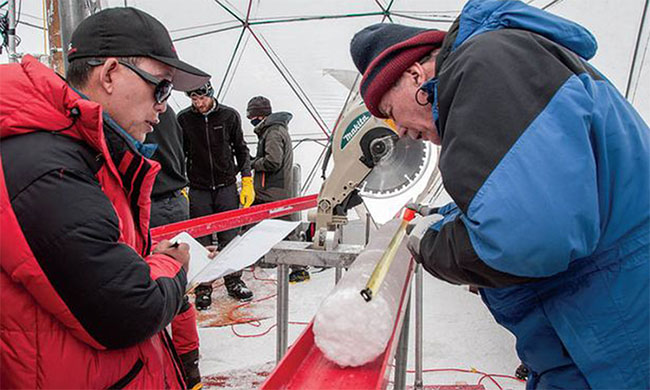The melted 15,000-year-old glacier could release new viruses
A team of US and Chinese scientists studied two ice cores from a glacier in the Tibetan Plateau and discovered 28 completely new virus samples.
The team of experts took three steps to remove pollutants from the ice core surface to conduct research, Daily Star reported on January 14. First, in a cold room of -5 degrees Celsius, they scrape off half a centimeter of ice with a saw. Next, the samples were washed with ethanol, then water. Analyzing two ice cores, the scientists discovered the genetic samples of 33 virus groups, of which 28 were completely new.

Scientists study ice cores.(Photo: Daily Star).
Traces of ancient microorganisms will provide more information about ancient climates and Earth's evolution. When climate change is great, scientists hope this information will help them understand which microorganisms are likely to survive and what the future environment will be like.
Global warming caused by humans is causing the world's glaciers to shrink , releasing microorganisms and viruses trapped inside for thousands of years. "This could damage the storage sample, which gives information about ancient Earth's climate. In a bad case, melting ice could release pathogens into the environment , " the team warned.
Most of these pathogens are unknown to scientists so it is almost impossible to predict their effects on humans. In 2016, anthrax broke out in Siberia, causing 96 people to be hospitalized and more than 2,000 caribou died. Anthrax germs can survive for a very long time. The plague was then thought to be due to the melting of the permafrost, revealing the infected reindeer carcass decades ago.
"The dangers that exist in the ice are real. With the worldwide melting of the ice, the risk of pathogens escaping also increases," Scott O Rogers, a professor at Bowling Green State University, wrote in A book.
Chantal Abergel, a researcher at the French National Center for Scientific Research, is not surprised that many viruses in the ice core are brand new."We have a long way to go before we can sample all the viruses on Earth ," Abergel said.
- Detect shock in the ice core in the Arctic - the most remote waters
- Detecting 720,000-year-old ice core can "prophesy" about the future of the Earth
- Smith Glacier Glacier melted much faster than expected
- The world's most dangerous glacier is about to melt, catastrophic with Earth?
- The Antarctic glacier melted easily to raise the sea level by 3.4 meters
- The giant ice sheet separated from Greenland
- The largest glacier in the Alps may disappear by 2100
- Greenland ice suddenly melted massively
- See the most spectacular glaciers in the world
- The youngest glacier on the planet
- Ice melted massively, 100 years from now, will the Arctic still have ice?
- Use the blanket blanket Alps
- Volcanoes erupted again on the glacier
- 100 days in Glacier park
 Why do potatoes have eyes?
Why do potatoes have eyes? 'Tragedy' the world's largest carnivorous life: Death becomes ... public toilet
'Tragedy' the world's largest carnivorous life: Death becomes ... public toilet Tomatoes were once considered 'poisonous' for 200 years
Tomatoes were once considered 'poisonous' for 200 years Detecting microscopic parasites on human face
Detecting microscopic parasites on human face